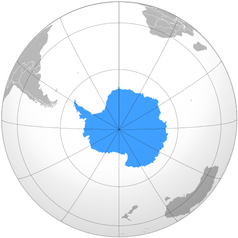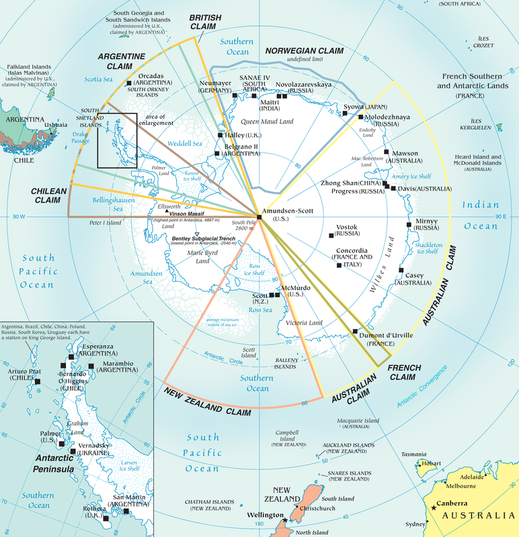Antarctica
|
Antarctica is Earth's southernmost continent, encapsulating the South Pole. It is situated in the Antarctic region of the southern hemisphere, almost entirely south of the Antarctic Circle, and is surrounded by the Southern Ocean. At 14.0 million km2 (5.4 million sq mi), it is the fifth-largest continent in area after Asia, Africa, North America, and South America. About 98% of Antarctica is covered by ice that averages at least 1.6 kilometres (1.0 mi) in thickness.
Antarctica, on average, is the coldest, driest, and windiest continent, and has the highest average elevation of all the continents.Antarctica is considered a desert, with annual precipitation of only 200 mm (8 inches) along the coast and far less inland (Cold Desert).There are no permanent human residents, but anywhere from 1,000 to 5,000 people reside throughout the year at the research stations scattered across the continent. Only cold-adapted plants and animals survive there, including penguins, seals, nematodes, tardigrades, mites, many types of algae and other microorganisms, and tundra vegetation.
Although myths and speculation about a Terra Australis ("Southern Land") date back to antiquity, the first confirmed sighting of the continent is commonly accepted to have occurred in 1820 by the Russian expedition of Fabian Gottlieb von Bellingshausen and Mikhail Lazarev. The continent, however, remained largely neglected for the rest of the 19th century because of its hostile environment, lack of resources, and isolation. The Antarctic Treaty was signed in 1959 by 12 countries; to date, 46 countries have signed the treaty. The treaty prohibits military activities and mineral mining, supports scientific research, and protects the continent's ecozone. Ongoing experiments are conducted by more than 4,000 scientists of many nationalities and with various research interests.
Antarctica, on average, is the coldest, driest, and windiest continent, and has the highest average elevation of all the continents.Antarctica is considered a desert, with annual precipitation of only 200 mm (8 inches) along the coast and far less inland (Cold Desert).There are no permanent human residents, but anywhere from 1,000 to 5,000 people reside throughout the year at the research stations scattered across the continent. Only cold-adapted plants and animals survive there, including penguins, seals, nematodes, tardigrades, mites, many types of algae and other microorganisms, and tundra vegetation.
Although myths and speculation about a Terra Australis ("Southern Land") date back to antiquity, the first confirmed sighting of the continent is commonly accepted to have occurred in 1820 by the Russian expedition of Fabian Gottlieb von Bellingshausen and Mikhail Lazarev. The continent, however, remained largely neglected for the rest of the 19th century because of its hostile environment, lack of resources, and isolation. The Antarctic Treaty was signed in 1959 by 12 countries; to date, 46 countries have signed the treaty. The treaty prohibits military activities and mineral mining, supports scientific research, and protects the continent's ecozone. Ongoing experiments are conducted by more than 4,000 scientists of many nationalities and with various research interests.
Etymology
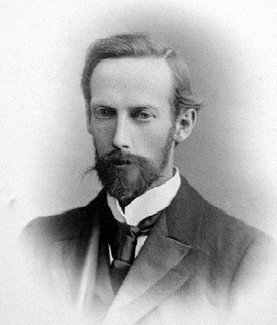
John George Bartholomew (22 March 1860 - 14 April 1920)
The first formal use of the name "Antarctica" as a continental name in the 1890s is attributed to the Scottish cartographer John George Bartholomew.
The name Antarctica is the romanized version of the Greek compound word ἀνταρκτική (antarktiké), feminine of ἀνταρκτικός (antarktikos),meaning "Opposite to the Arctic", "opposite to the north".
The name Antarctica is the romanized version of the Greek compound word ἀνταρκτική (antarktiké), feminine of ἀνταρκτικός (antarktikos),meaning "Opposite to the Arctic", "opposite to the north".
Geography of Antarctica
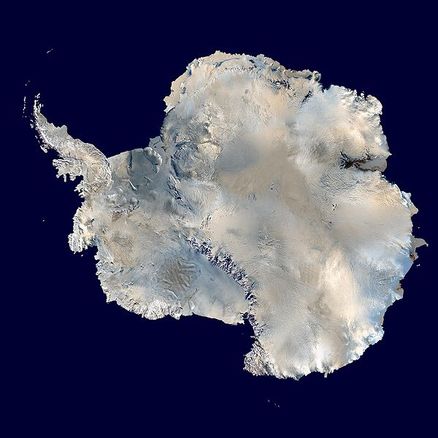
The geography of Antarctica is dominated by its south polar location and, thus, by ice. The Antarctic continent, located in the Earth's southern hemisphere, is centered asymmetrically around the South Pole and largely south of the Antarctic Circle. It is surrounded by the southern waters of the World Ocean alternatively (depending on source), it is washed by the Southern (or Antarctic) Ocean or the southern Pacific, Atlantic, and Indian Oceans. With an area of more than 14 million km², it is the fifth-largest continent and about 1.3 times larger than Europe.
Antarctica is divided in two by the Transantarctic Mountains close to the neck between the Ross Sea and the Weddell Sea. The portion west of the Weddell Sea and east of the Ross Sea is called West Antarctica and the remainder East Antarctica, because they roughly correspond to the Western and Eastern Hemispheres relative to the Greenwich meridian.
About 98% of Antarctica is covered by the Antarctic ice sheet, a sheet of ice averaging at least 1.6 km (1.0 mi) thick. The continent has about 90% of the world's ice (and thereby about 70% of the world's fresh water). If all of this ice were melted, sea levels would rise about 60 m (200 ft).In most of the interior of the continent, precipitation is very low, down to 20 mm (0.8 in) per year; in a few "blue ice" areas precipitation is lower than mass loss by sublimation and so the local mass balance is negative. In the dry valleys the same effect occurs over a rock base, leading to a desiccated landscape.
West Antarctica is covered by the West Antarctic Ice Sheet. The sheet has been of recent concern because of the real, if small, possibility of its collapse. If the sheet were to break down, ocean levels would rise by several metres in a relatively geologically short period of time, perhaps a matter of centuries. Several Antarctic ice streams, which account for about 10% of the ice sheet, flow to one of the many Antarctic ice shelves.
East Antarctica lies on the Indian Ocean side of the Transantarctic Mountains and comprises Coats Land, Queen Maud Land, Enderby Land, Mac Robertson Land, Wilkes Land and Victoria Land. All but a small portion of this region lies within the Eastern Hemisphere. East Antarctica is largely covered by the East Antarctic Ice Sheet.Only about 2% of the continent is uncovered by ice.
Vinson Massif, the highest peak in Antarctica at 4,892 m (16,050 ft), is located in the Ellsworth Mountains. Antarctica contains many other mountains, both on the main continent and the surrounding islands. Located on Ross Island, Mount Erebus is the world's southernmost active volcano. Another well-known volcano is found on Deception Island, which is famous for a giant eruption in 1970. Minor eruptions are frequent and lava flow has been observed in recent years. Other dormant volcanoes may potentially be active.In 2004, an underwater volcano was found in the Antarctic Peninsula by American and Canadian researchers. Recent evidence shows this unnamed volcano may be active.
Antarctica is home to more than 70 lakes that lie at the base of the continental ice sheet. Lake Vostok, discovered beneath Russia's Vostok Station in 1996, is the largest of these subglacial lakes. It was once believed that the lake had been sealed off for 500,000 to one million years but a recent survey suggests that, every so often, there are large flows of water from one lake to another.
Antarctica is divided in two by the Transantarctic Mountains close to the neck between the Ross Sea and the Weddell Sea. The portion west of the Weddell Sea and east of the Ross Sea is called West Antarctica and the remainder East Antarctica, because they roughly correspond to the Western and Eastern Hemispheres relative to the Greenwich meridian.
About 98% of Antarctica is covered by the Antarctic ice sheet, a sheet of ice averaging at least 1.6 km (1.0 mi) thick. The continent has about 90% of the world's ice (and thereby about 70% of the world's fresh water). If all of this ice were melted, sea levels would rise about 60 m (200 ft).In most of the interior of the continent, precipitation is very low, down to 20 mm (0.8 in) per year; in a few "blue ice" areas precipitation is lower than mass loss by sublimation and so the local mass balance is negative. In the dry valleys the same effect occurs over a rock base, leading to a desiccated landscape.
West Antarctica is covered by the West Antarctic Ice Sheet. The sheet has been of recent concern because of the real, if small, possibility of its collapse. If the sheet were to break down, ocean levels would rise by several metres in a relatively geologically short period of time, perhaps a matter of centuries. Several Antarctic ice streams, which account for about 10% of the ice sheet, flow to one of the many Antarctic ice shelves.
East Antarctica lies on the Indian Ocean side of the Transantarctic Mountains and comprises Coats Land, Queen Maud Land, Enderby Land, Mac Robertson Land, Wilkes Land and Victoria Land. All but a small portion of this region lies within the Eastern Hemisphere. East Antarctica is largely covered by the East Antarctic Ice Sheet.Only about 2% of the continent is uncovered by ice.
Vinson Massif, the highest peak in Antarctica at 4,892 m (16,050 ft), is located in the Ellsworth Mountains. Antarctica contains many other mountains, both on the main continent and the surrounding islands. Located on Ross Island, Mount Erebus is the world's southernmost active volcano. Another well-known volcano is found on Deception Island, which is famous for a giant eruption in 1970. Minor eruptions are frequent and lava flow has been observed in recent years. Other dormant volcanoes may potentially be active.In 2004, an underwater volcano was found in the Antarctic Peninsula by American and Canadian researchers. Recent evidence shows this unnamed volcano may be active.
Antarctica is home to more than 70 lakes that lie at the base of the continental ice sheet. Lake Vostok, discovered beneath Russia's Vostok Station in 1996, is the largest of these subglacial lakes. It was once believed that the lake had been sealed off for 500,000 to one million years but a recent survey suggests that, every so often, there are large flows of water from one lake to another.
Climate of Antarctica
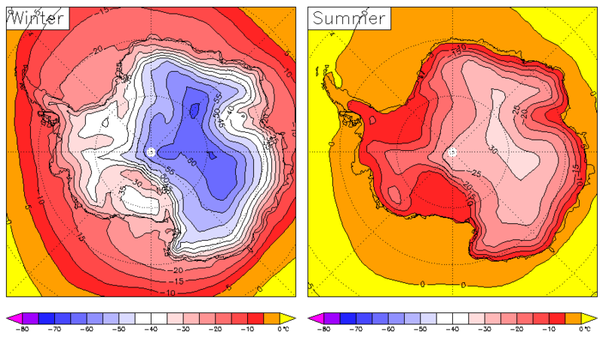
Antarctica is the coldest place on Earth. The coldest natural temperature ever recorded on Earth was -89.2 °C (-128.6 °F) at the Russian Vostok Station in Antarctica on 21 July 1983.For comparison, this is 11 °C (20 °F) colder than subliming dry ice. Antarctica is a frozen desert with little precipitation; the South Pole itself receives less than 10 cm (4 in) per year, on average. Temperatures reach a minimum of between -80 °C (-112 °F) and -90 °C (-130 °F) in the interior in winter and reach a maximum of between 5 °C (41 °F) and 15 °C (59 °F) near the coast in summer. Sunburn is often a health issue as the snow surface reflects almost all of the ultraviolet light falling on it.
East Antarctica is colder than its western counterpart because of its higher elevation. Weather fronts rarely penetrate far into the continent, leaving the center cold and dry. Despite the lack of precipitation over the central portion of the continent, ice there lasts for extended time periods. Heavy snowfalls are not uncommon on the coastal portion of the continent, where snowfalls of up to 1.22 metres (48 in) in 48 hours have been recorded.
At the edge of the continent, strong katabatic winds off the polar plateau often blow at storm force. In the interior, however, wind speeds are typically moderate. During summer, more solar radiation reaches the surface during clear days at the South Pole than at the equator because of the 24 hours of sunlight each day at the Pole.
East Antarctica is colder than its western counterpart because of its higher elevation. Weather fronts rarely penetrate far into the continent, leaving the center cold and dry. Despite the lack of precipitation over the central portion of the continent, ice there lasts for extended time periods. Heavy snowfalls are not uncommon on the coastal portion of the continent, where snowfalls of up to 1.22 metres (48 in) in 48 hours have been recorded.
At the edge of the continent, strong katabatic winds off the polar plateau often blow at storm force. In the interior, however, wind speeds are typically moderate. During summer, more solar radiation reaches the surface during clear days at the South Pole than at the equator because of the 24 hours of sunlight each day at the Pole.
History of Antarctica
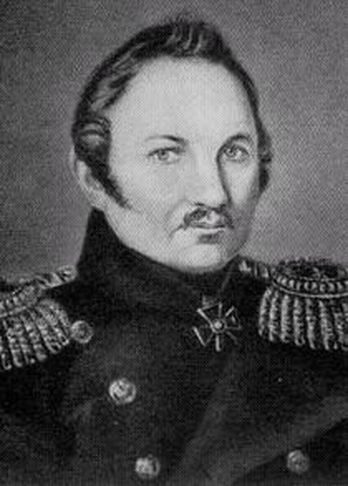
Bellingshausen- first person to see the continent of Antarctica
The history of Antarctica emerges from early Western theories of a vast continent, known as Terra Australis, believed to exist in the far south of the globe. The term Antarctic, referring to the opposite of the Arctic Circle, was coined by Marinus of Tyre in the 2nd century AD.
The rounding of the Cape of Good Hope and Cape Horn in the 15th and 16th centuries proved that Terra Australis Incognita ("Unknown Southern Land"), if it existed, was a continent in its own right.
European maps continued to show this hypothetical land until Captain James Cook's ships, HMS Resolution and Adventure, crossed the Antarctic Circle on 17 January 1773, in December 1773 and again in January 1774.Cook in fact came within about 75 miles (121 km) of the Antarctic coast before retreating in the face of field ice in January 1773.
The first confirmed sighting of Antarctica can be narrowed down to the crews of ships captained by three individuals. According to various organizations (The National Science Foundation,NASA,the University of California, San Diego,and other sources),ships captained by three men sighted Antarctica in 1820: Fabian Gottlieb von Bellingshausen (An Estonian-born captain in the Russian Imperial Navy), Edward Bransfield (A Ireland-born captain in the Royal Navy), and Nathaniel Palmer (An American sealer out of Stonington, Connecticut). Von Bellingshausen saw Antarctica on 27 January 1820, three days before Bransfield sighted land, and ten months before Palmer did so in November 1820. On that day the two-ship expedition led by Von Bellingshausen and Mikhail Petrovich Lazarev reached a point within 32 kilometers (20 mi) of the Antarctic mainland and saw ice fields there.
The first landing was probably just over a year later when American Captain John Davis, a sealer, set foot on the ice.
The first Norwegian expedition to Antarctica was led by Captain Carl Anton Larsen aboard the barque Jason in 1892. During the expedition he was the first to discover fossils in Antarctica, for which he received the Back Grant from the Royal Geographical Society.In December 1893 he also became the first person to ski in Antarctica where the Larsen Ice Shelf was named after him. Larsen is also considered the founder of the Antarctic whaling industry and the settlement at Grytviken, South Georgia.
Once the North Pole had been reached in 1909, several expeditions attempted to reach the South Pole. Many resulted in injury and death.An expedition led by Norwegian polar explorer Roald Amundsen from the ship Fram became the first to reach the geographic South Pole on 14 December 1911, using a route from the Bay of Whales and up the Axel Heiberg Glacier.Richard Evelyn Byrd led several voyages to the Antarctic by plane in the 1930s and 1940s. He is credited with implementing mechanized land transport on the continent and conducting extensive geological and biological research.However, it was not until 31 October 1956 that anyone set foot on the South Pole again; on that day a U.S. Navy group led by Rear Admiral George J. Dufek successfully landed an aircraft there.
The rounding of the Cape of Good Hope and Cape Horn in the 15th and 16th centuries proved that Terra Australis Incognita ("Unknown Southern Land"), if it existed, was a continent in its own right.
European maps continued to show this hypothetical land until Captain James Cook's ships, HMS Resolution and Adventure, crossed the Antarctic Circle on 17 January 1773, in December 1773 and again in January 1774.Cook in fact came within about 75 miles (121 km) of the Antarctic coast before retreating in the face of field ice in January 1773.
The first confirmed sighting of Antarctica can be narrowed down to the crews of ships captained by three individuals. According to various organizations (The National Science Foundation,NASA,the University of California, San Diego,and other sources),ships captained by three men sighted Antarctica in 1820: Fabian Gottlieb von Bellingshausen (An Estonian-born captain in the Russian Imperial Navy), Edward Bransfield (A Ireland-born captain in the Royal Navy), and Nathaniel Palmer (An American sealer out of Stonington, Connecticut). Von Bellingshausen saw Antarctica on 27 January 1820, three days before Bransfield sighted land, and ten months before Palmer did so in November 1820. On that day the two-ship expedition led by Von Bellingshausen and Mikhail Petrovich Lazarev reached a point within 32 kilometers (20 mi) of the Antarctic mainland and saw ice fields there.
The first landing was probably just over a year later when American Captain John Davis, a sealer, set foot on the ice.
The first Norwegian expedition to Antarctica was led by Captain Carl Anton Larsen aboard the barque Jason in 1892. During the expedition he was the first to discover fossils in Antarctica, for which he received the Back Grant from the Royal Geographical Society.In December 1893 he also became the first person to ski in Antarctica where the Larsen Ice Shelf was named after him. Larsen is also considered the founder of the Antarctic whaling industry and the settlement at Grytviken, South Georgia.
Once the North Pole had been reached in 1909, several expeditions attempted to reach the South Pole. Many resulted in injury and death.An expedition led by Norwegian polar explorer Roald Amundsen from the ship Fram became the first to reach the geographic South Pole on 14 December 1911, using a route from the Bay of Whales and up the Axel Heiberg Glacier.Richard Evelyn Byrd led several voyages to the Antarctic by plane in the 1930s and 1940s. He is credited with implementing mechanized land transport on the continent and conducting extensive geological and biological research.However, it was not until 31 October 1956 that anyone set foot on the South Pole again; on that day a U.S. Navy group led by Rear Admiral George J. Dufek successfully landed an aircraft there.
Antarctic territories
Antarctica has no government, although various countries claim sovereignty in certain regions. While a few of these countries have mutually recognised each other's claims,the validity of these claims is generally not recognised universally.Seven sovereign states had made eight territorial claims to land in Antarctica below the 60° S parallel before 1961. These claims have been recognized only between the countries making claims in the area. All claim areas are sectors, with the exception of Peter I Island. None of these claims has an indigenous population. The South Orkney Islands fall within the territory claimed by Argentina and United Kingdom; and the South Shetland Islands fall within the areas claimed by Argentina, Chile, and the United Kingdom. The UK, France, Australia, New Zealand and Norway all recognize each others' claims, which do not overlap. Prior to 1962, British Antarctic Territory was a dependency of the Falkland Islands and also included South Georgia and the South Sandwich Islands. The Antarctic areas became a separate overseas territory following the ratification of the Antarctic Treaty. South Georgia and the South Sandwich Islands remained a dependency of the Falkland Islands until 1985 when they too became a separate overseas territory.
New claims on Antarctica have been suspended since 1959 and the continent is considered politically neutral. Its status is regulated by the 1959 Antarctic Treaty and other related agreements, collectively called the Antarctic Treaty System. Antarctica is defined as all land and ice shelves south of 60° S for the purposes of the Treaty System.The treaty, entering into force in 1961 and eventually signed by 45 countries, sets aside Antarctica as a scientific preserve, establishes freedom of scientific investigation and bans military activity on that continent.
New claims on Antarctica have been suspended since 1959 and the continent is considered politically neutral. Its status is regulated by the 1959 Antarctic Treaty and other related agreements, collectively called the Antarctic Treaty System. Antarctica is defined as all land and ice shelves south of 60° S for the purposes of the Treaty System.The treaty, entering into force in 1961 and eventually signed by 45 countries, sets aside Antarctica as a scientific preserve, establishes freedom of scientific investigation and bans military activity on that continent.
|
|
Research stations of Antarctica
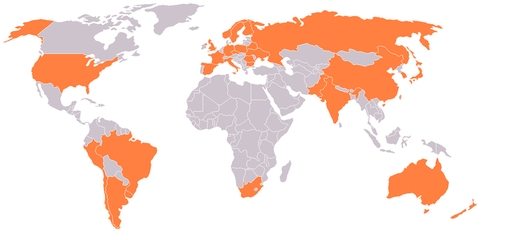
Nations of the world that have stations on the continent of Antarctica as of October 2006.
A number of governments maintain permanent research stations throughout Antarctica. Many of the stations are staffed around the year. A total of 30 countries (as of October 2006), all signatory to the Antarctic Treaty, operate seasonal (summer) and year-round research stations on the continent and in its surrounding oceans.
Researchers include biologists, geologists, oceanographers, physicists, astronomers, glaciologists, and meteorologists. Geologists tend to study plate tectonics, meteorites from outer space, and resources from the breakup of the supercontinent Gondwanaland. Glaciologists in Antarctica are concerned with the study of the history and dynamics of floating ice, seasonal snow, glaciers, and ice sheets. Biologists, in addition to examining the wildlife, are interested in how harsh temperatures and the presence of people affect adaptation and survival strategies in a wide variety of organisms. Medical physicians have made discoveries concerning the spreading of viruses and the body's response to extreme seasonal temperatures. Astrophysicists at Amundsen-Scott South Pole Station study the celestial dome and cosmic microwave background radiation.
Researchers include biologists, geologists, oceanographers, physicists, astronomers, glaciologists, and meteorologists. Geologists tend to study plate tectonics, meteorites from outer space, and resources from the breakup of the supercontinent Gondwanaland. Glaciologists in Antarctica are concerned with the study of the history and dynamics of floating ice, seasonal snow, glaciers, and ice sheets. Biologists, in addition to examining the wildlife, are interested in how harsh temperatures and the presence of people affect adaptation and survival strategies in a wide variety of organisms. Medical physicians have made discoveries concerning the spreading of viruses and the body's response to extreme seasonal temperatures. Astrophysicists at Amundsen-Scott South Pole Station study the celestial dome and cosmic microwave background radiation.

